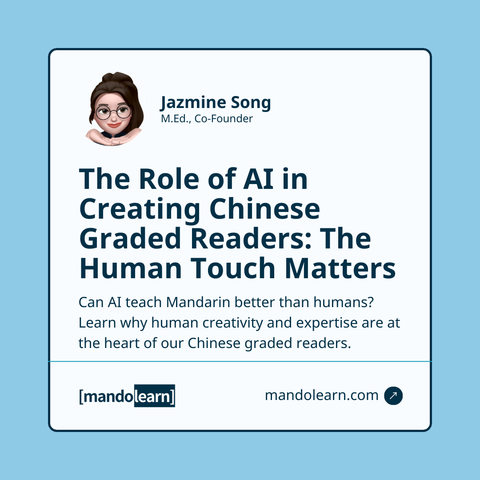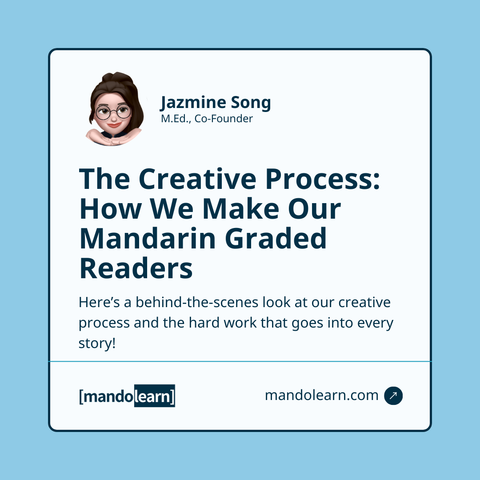🤖 Can AI write a meaningful story or teach language learners better than humans? At MandoLearn, we’ve found AI can be a helpful tool for small, repetitive tasks—but the real magic happens when humans are in charge. In this post, we’ll share exactly how we use AI (spoiler: it’s very limited), why it falls short in so many areas, and why the human touch is at the heart of everything we do.
How We Use AI at MandoLearn
- Footnote Generation: At MandoLearn, AI is used in just one part of our workflow: generating footnotes. After we’ve created the word list for a chapter, we use AI to generate pinyin, zhuyin, and basic definitions for those words. Even then, AI isn’t perfect. We review every entry to ensure the definitions fit the context and that the pinyin and Zhuyin are accurate.
What We Don’t Use AI For
There are some things AI just can’t do. For example:
- Localizing Language to Taiwan/China Mandarin: While converting simplified to traditional characters can be done with one click, we handle all the language adaptations between Taiwan and China Mandarin ourselves. This ensures that every detail feels natural and consistent. When we convert to traditional, we specifically instruct ChatGPT not to change any words, so we can personally oversee every adjustment. The language differences between the two regions can be subtle. Very often we will have discussions with locals to choose the most accurate word or phrase. (Shoutout to Song’s online gaming friends for helping us nail authentic Taiwanese translations—thanks, guys!✌️)
- Story Writing or Creativity: Every story we publish is written entirely by Song. We strongly believe that tasks requiring creativity, linguistic nuance, and cultural understanding are best left to humans.
- Audio Recordings: All our audio is recorded by real people. Song records the China Mandarin version himself, while we hire a voice artist (Pin-En Wang) from Taiwan for the Taiwan Mandarin version.
- Character Drawings on the Covers: All our covers are designed by real artists, not AI. After experimenting with AI-generated art early on, we realized that nothing compares to the creativity, personality, and care that human artists bring to the table. Just like we can tell AI-generated writing/graded readers almost right away, artists can tell AI-generated art right away.
Where AI Falls Short
AI might be good at repetitive tasks, but it struggles with the specific needs of language learners. For example:
- AI doesn’t simplify texts properly. (We’ve tested…🧐) It often makes things more complicated or creates sentences that sound unnatural—even like classical Chinese at times.
- AI doesn’t stick to specific HSK levels. Its output spans multiple levels, creating inconsistency that’s confusing for learners. We’ve seen other new graded readers that rely heavily on AI, and the results are clear: the flow is awkward, grammar patterns don’t feel intentional, and the overall story feels flat. 🚨 We won’t name names, but beware of any graded readers that span across multiple HSK levels, especially if that range is more than 2 levels. 🚨
- AI sucks at writing good stories: AI isn’t capable of writing engaging, meaningful stories. It relies on pre-existing data, so it struggles to innovate or create something that resonates with our emotions. This is why we do all of our own storytelling.
How We Use AI in Workflow
Here’s exactly how AI fits into our workflow:
- 🧑🏻💻 Outline: Song outlines the entire story plot.
- 🧑🏻💻 Manuscript: Song writes the manuscript, using an HSK word list as a guide to ensure the story stays within the level.
- 🧑🏻💻 Word Lists: We create a word list for each chapter, choosing which words are outside of the corresponding HSK level.
- 🤖 Footnotes: The word list is fed to ChatGPT to generate pinyin, zhuyin, and basic definitions.
- 🧑🏻💻 Footnotes Editing: We review, edit, and format every footnote before adding it to the book.
- 🧑🏻💻 Audio: Song or Pin-En Wang record the audio. Jazmine edits.
- 🧑🏻💻 Cover: The cover gets drawn by our artist (Mister D) on Fiverr.
What Learners Can Expect from MandoLearn
At MandoLearn, our priority is authenticity and quality. While we use AI for minor tasks like footnotes, the stories, cultural adaptations, and overall content are crafted entirely by us.
We put so much thought into every word choice, grammar pattern, and cultural detail to ensure that our books are both engaging and effective for Mandarin learners. You can trust that behind every book are many real people.
Final Thoughts
Thank you for supporting a process that prioritizes creativity, quality, and your learning experience. AI might be helpful for technical tasks, but it will never replace the care and thoughtfulness of the human touch.
⬇️ What’s your take on AI in arts and education? Let us know in the comments—we’d love to hear your thoughts!




Comments (0)
There are no comments for this article. Be the first one to leave a message!